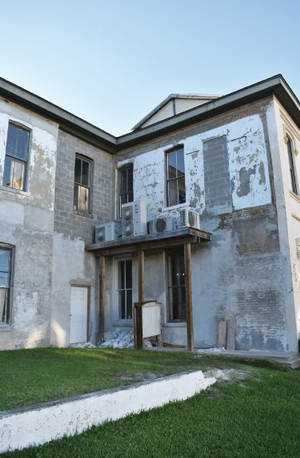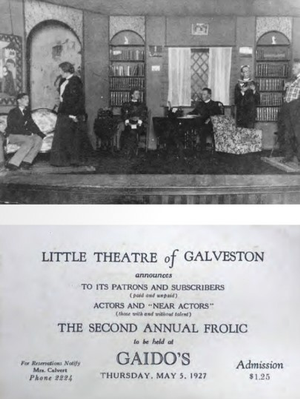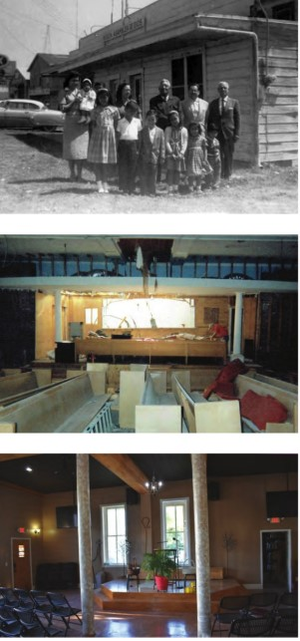In a city such as Galveston, where the history is not only
captivating but also a distinct facet of the cultural identity, the buildings
are as storied as the community. When these two evolve together, rather than
demolishing one at the whims of the other, ideas come to be planted in
seemingly illogical places - banks become restaurants, warehouses become retail
centers, and theatres become churches.
Sitting
quietly on the corner of 18th and Postoffice Street is a seemingly
forgettable structure, its greyish, monochromatic stucco no match for the
kaleidoscopic gingerbreads that surround it. But this demure exterior is a mere
façade for the wellspring of hope and enthusiasm that has been nurtured within
its walls for nearly a century.
 1801 Postoffice Street
has been the home of the East End First Assembly of God Church since the 1960s.
Founded in July 1959 as Mision Asamblea De Dios, the church was first
established in a modest wood-frame building at 5915 Broadway before moving to
its current location.
1801 Postoffice Street
has been the home of the East End First Assembly of God Church since the 1960s.
Founded in July 1959 as Mision Asamblea De Dios, the church was first
established in a modest wood-frame building at 5915 Broadway before moving to
its current location.
“We
changed the name because we wanted to be more inclusive, more welcoming to all
people,” says Pastor Lily Rodriguez who has been at the helm since 2004. Her
dedication and tenacity is nothing short of inspiring, as her efforts are
fostered by both a heart for the island community and a sincere love for its
history.
“In
the 90s, I was employed by Galveston Historical Foundation (GHF) as a
receptionist and a docent at Ashton Villa and the Samuel May Williams home.
This prepared a great foundational education in preservation,” she says.
Now, the church building has given her the opportunity to parlay her
experience with her current ministry - she has worked for over a decade to
restore the building, a task made difficult by significant modifications in the
1970s as well as Hurricane Ike.
Lily
continues, “My experience with GHF in turn defined my focus with the church,
when I was looking at this hidden treasure after the devastating effects of an
8-foot storm surge that would have ended the vision once placed on the location
by others so long ago.”
But
even after all this time, only about one-third of the building’s interior is
functional, yet Lily continues undaunted, determined to see the church’s vision
fulfilled. Fortunately, she has history on her side, as the building already
holds a legacy of resolute occupants seeking not wealth or status, but only to
make a difference.
 The Little Theatre movement began in Paris in 1887 when Andre Antoine opened the
first playhouse to fully realize the concept of intimacy between the audience
and the actors. The movement spread to the United States around 1911 and was
adopted in large part to save theatre from outright extinction at the hands of
cinema.
The Little Theatre movement began in Paris in 1887 when Andre Antoine opened the
first playhouse to fully realize the concept of intimacy between the audience
and the actors. The movement spread to the United States around 1911 and was
adopted in large part to save theatre from outright extinction at the hands of
cinema.
As
movies were quickly beginning to replace live performance as the preferred
source of large-scale entertainment, small theatre companies began to form and
collectively rallied to rescue the theatre merely for the sake of theatre
itself, to preserve the most persistent of art forms.
In addition to providing a unique theatre-going experience, Little
Theatres served as experimental centers both in form and in content. The were
non-commercial, not-for-profit, and often composed of reform-minded,
envelope-pushing members.
An
uncredited essay on the topic states definitively, “Little Theatres are
established from love of drama, not from love of gain. The workers are drawn
together by the same impulse - they are artists or potential artists in the
craft of acting, play-writing, stage decoration or stage management.”
The
purity of this intention galvanized the movement, completely revolutionizing
theatre in the United States
and most importantly, gifting it with posterity. The Little Theatre movement
was the precursor to Off-Broadway established in the 1950s, as well as the
template with which college laboratory theatres and open-air theatres were
created.
Community
theatre is also noted as a distant off-shoot of Little Theatre, although the
present-day equivalent is more likened to the production houses officially
known in the theatre realm as “semi-professional,” such as the Island East-End
Theatre Company (ETC) in downtown Galveston.
Galveston caught its
first glimpse of the movement at a meeting of the Wednesday Club, a women’s
club that met regularly at the Rosenberg Library to discuss papers on a variety
of topics. They invited Oliver Hinsdell, director of the Little Theatre in New Orleans, to speak at the home of Mrs. William L.
Moody, Jr., wife to the president of American National Insurance Company and
matriarch of one of Galveston’s
premiere families.
This
presentation was followed by an invitation to Howard Jones, a University of Texas
professor and the director of a Little Theatre called Curtain Club, to speak at
a PTA meeting.
His
compelling case for perpetuating the art of theatre through this movement
allowed the Wednesday Club to enlist the support of another ladies’ social club
called the Round Table of Galveston, and thus was formed the Galveston Little
Theatre. The efforts were also assisted by Mrs. I.H. Kempner who was later
elected the second President of the theatre’s board and remained in the
position for several years.
Jones had suggested that the group hire a director and produce one play
to see if Galveston
would support the concept. One of his set designers from the Curtain Club,
Peter Ames Vincent was chosen to direct the experimental production.
The
women worked tirelessly and gathered 179 original subscribers before a location
for the first play had even been chosen. They decided upon Garten Verein, and
in the spring of 1923, an estimated 800 people attended two showings of The
Truth starring Mildred Oser, secretary to the Superintendent of Schools.
Ames returned in the fall
and began work on a second play, Rollo’s Wild Cat, and followed that
with a presentation of three one-act plays during the Christmas season
including In the Zone by Eugene O’Neil, a personal friend of Peter’s. A
handwritten letter from O’Neil to Vincent presently housed at the Galveston & Texas History Center
reveals that the playwright happily waived his royalty fee for his friend.
Galveston Little Theatre’s production of In the Zone was the first time
one of his plays was produced in Texas.
As the popularity of their productions grew over the next few years, the
board of directors began actively seeking to acquire property. At their meeting
on June 8, 1926, Mrs. Kempner announced that a building had been found at 18th
and Postoffice for a price of $7,500; an additional $5,000 would be needed for
the remodel.
Mr.
Kempner loaned the purchase amount at 6% over six years through his First Texas
Prudential Insurance Company. Three days later, on June 11, the Galveston
Little Theatre Corporation was officially chartered.
 From
that point forward, even though any given board member could have simply asked
their husband to write a check, Galveston Little Theatre was self-sustaining
via the concerted fundraising and publicity efforts of the women in charge.
From
that point forward, even though any given board member could have simply asked
their husband to write a check, Galveston Little Theatre was self-sustaining
via the concerted fundraising and publicity efforts of the women in charge.
Built circa 1887, the newly minted theatre property was originally a
boarding house. The main building sat on the northern half of the corner lot
and behind it, a carriage house was located on the southwest quadrant. These
two buildings were connected by a two-story porch and breezeway.
The
sleeping rooms on the second floor of the main building were maintained and
rented out to tenants, and the carriage house was converted into the backstage
area with storage and dressing rooms. The main floor was built out into an
auditorium measuring 39 feet by 40 feet by 13 feet.
The
walls were painted “orchard” and a stage was placed against the south wall,
flanked by a false proscenium arch painted deep blue. Theatre goers would be
seated in special-order chairs with a walnut finish that could be arranged into
rows sloping downward toward the stage for maximum visibility.
Peter Ames Vincent was hired as the permanent director, although he gave
himself a new title, that of “Regisseur” meaning the one who “must know all and
do all in the theatre” (the modern equivalent of a Producer).
Vincent
was bold and passionate with an uncanny eye for detail and the subtleties
required for good theatre. Beloved by the board and the company members, he
became a well-known resident and was heralded as a champion of the arts for his
thought-provoking productions and skilled maintenance of Galveston’s theatre scene.
Although
he received many offers from theatres in other cities, Peter Ames Vincent
remained with the Galveston
theatre until his death in 1930, producing 34 plays in six years. His obituary
in the Galveston Tribune stated, “Under his direction, the Little
Theatre group of Galveston
became recognized throughout the country for their high degree of artistic
excellence in productions.”
The artistic integrity of the theatre faltered after Vincent’s death,
but his fate seemed almost kind when the vice grip of the Great Depression
choked out expendable income and the theatre began to struggle financially. In
1934, the Kempners and the board of the Galveston Little Theatre reluctantly
agreed to sell the building to W.L. Moody, Jr., who announced upon the
completion of the sale that he would keep the building open for dramatic
performances by any group interested in producing one.
Two
separate groups were formed by former Vincent proteges, one of which did
officially incorporate as the Galveston Little Theatre, Inc. These groups were
responsible for initiating a brief revival of local theatre, until they were
again forced into an untimely intermission in 1944 by the ripple effects of
World War II.
Four
years later, Galveston Little Theatre returned one last time for a Silver
Anniversary performance that would be its last, a production of Front Porch,
a play that would later open on Broadway as Picnic in 1953. From
its inception in 1923 until its curtain call in 1948, Galveston Little Theatre
amassed a repertoire of 89 plays brought to life by 1,042 local actors.
In the 1970s, after the building was acquired by the church but before Galveston had fully
grasped the fact that its “old” buildings were fast-approaching “historic”
status, significant alterations were made to the entire property. An addition
was constructed on the southeast quadrant, closing in the carriage house and
the back porches to create one large building.
The
south wall behind the stage was demolished and a baptismal was placed where the
first-floor porch had been located. The new construction housed a dining hall,
and the old carriage house/backstage area served as the pastor’s office and
living quarters.
The
original slope and theatre chairs were still part of the church when Lily
Rodriguez began attending, but a beautiful, winding front staircase had been
entirely sealed off and drop-down ceilings were installed which significantly
dwarfed the auditorium-turned-sanctuary.
Then in 2008, Hurricane Ike provided for the East End Assembly of God as
it had for so many across the island - a canvas of creativity stretched by
destruction. The roof was obliterated, leading to widespread water damage on
the second floor; an eight-foot storm surge did the same to the first floor.
Since
then, Pastor Lily has dedicated a large part of her life and livelihood to
implementing repairs and reclaiming the building, a journey that continues to
this day. “It has been difficult, but it has been rewarding,” she says.
“We’d
get a ‘yes,’ then we’d get a ‘no,’ we would make progress and then and obstacle
would come along, but after every obstacle, there was an even bigger blessing.”
The 1970s addition was demolished in the aftermath of Ike, but Lily says
cheerily, “That actually restored the building to its original footprint.”
During that demolition, the baptismal was removed and the south wall was
replaced which now boasts beautiful bay windows and a sunlit view of East End architecture. The front staircase was discovered
and uncovered, the drop-down ceilings were removed to reveal a beautifully
lofted main floor, and support beams were placed to reinforce the second floor.
In
2012, the building’s windows were restored to their original condition. Designs
for the carriage house and former boarding rooms have been drafted, and work
has begun on converting those into kitchen and bathroom facilities and
classrooms, respectively.
“We have had an amazingly supportive community since Ike in the way of
guidance and direction. The ‘RV-ers’ came and performed repairs free of charge,
and the City of Galveston Landmark Commission and permit department have been a
blessing to us as well,” Lily says.
“My
good friend Greg Lewis has been one of our biggest supporters, an amazing donor
of time, experience, and expertise. Vera Green and Luke Pronker with Frame
Design as well have provided structural engineering needs, advice, and
drawings. We also received a grant from the Moody Foundation.”
Indeed, Pastor Lily does not seem like she has been at this for eleven
years, rather it seems like her first day on the job, brimming with hope and
keenly focused on the church’s mission.
“I
even had an offer from Galveston Historical Foundation to purchase the building
after the storm, but I just couldn’t do it. Not only did I know the true value
of this building once it is restored, more importantly, I could not sacrifice
the vision of this church. Those first members, who saw this building and
wanted to make it their home, I could not abandon their dream.”
Just
like the theatre that came before, the East End First Assembly of God has only
one form of currency- a heartfelt combination of purpose,
hope, and persistence.
To
find out how you can help Pastor Lily restore the Little Theatre Building,
contact her directly at EastEnd1stAG.primera@gmail.com or 409.939.9632.